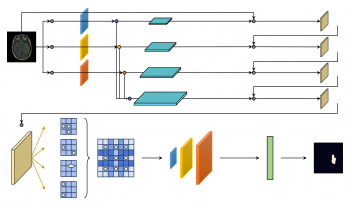Abstract
Purpose: Gliomas, particularly brain tumors, pose significant challenges due to their complex pathology and life-threatening potential. The goal of this study is to introduce LU-net, a novel semantic segmentation algorithm designed to enhance the diagnosis and treatment planning of gliomas. This research seeks to address the limitations of traditional classification and detection methods by improving the accuracy and robustness of tumor boundary delineation in medical images. Methods: LU-net employs a multiscale image pyramid along with a Bayesian-inference-based multiscale probability search to capture complex tumor features. The algorithm is further strengthened by integrating a Conditional Random Field model, enabling more precise segmentation. The performance of LU-net is evaluated against existing segmentation algorithms using standard metrics such as accuracy, Intersection over Union (IoU), and Dice score. Results: The experimental results demonstrate that LU-net outperforms current segmentation algorithms in terms of both accuracy and robustness. Specifically, LU-net achieves an accuracy of 0.9953, an IoU of 0.667, and a Dice score of 0.566, effectively addressing the pathological heterogeneity and invasiveness of gliomas. These results highlight LU-net’s superior ability to delineate tumor boundaries and improve diagnostic accuracy. Conclusion: LU-net sets a new benchmark in glioma lesion detection, offering a more effective approach for brain tumor segmentation. By improving the accuracy, reliability, and interpretability of brain tumor boundary delineation, LU-net enhances diagnostic and treatment strategies, providing significant benefits to patients, clinicians, and healthcare providers. Overall, this work marks a significant contribution to the field of medical imaging and glioma diagnosis.

 Find this author on Google Scholar
Find this author on Google Scholar Find this author on PubMed
Find this author on PubMed